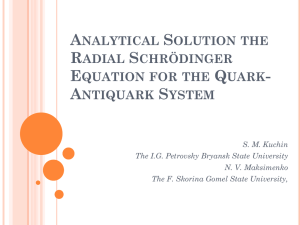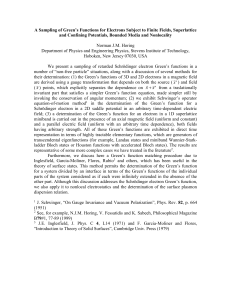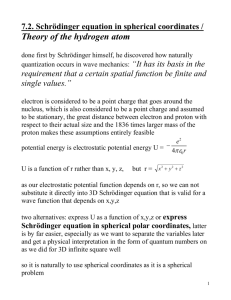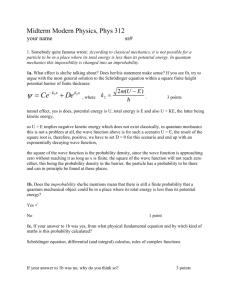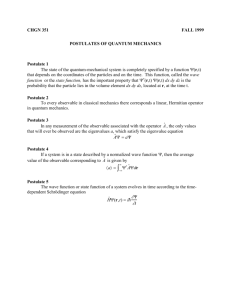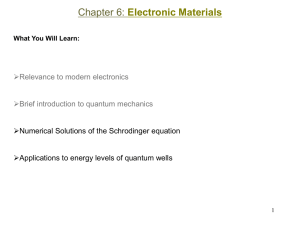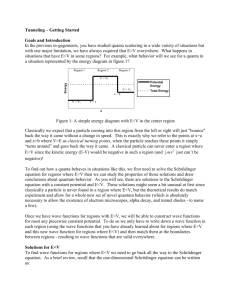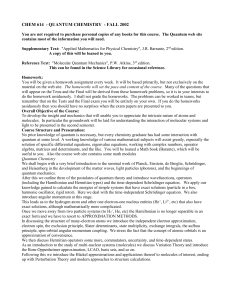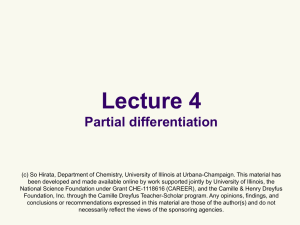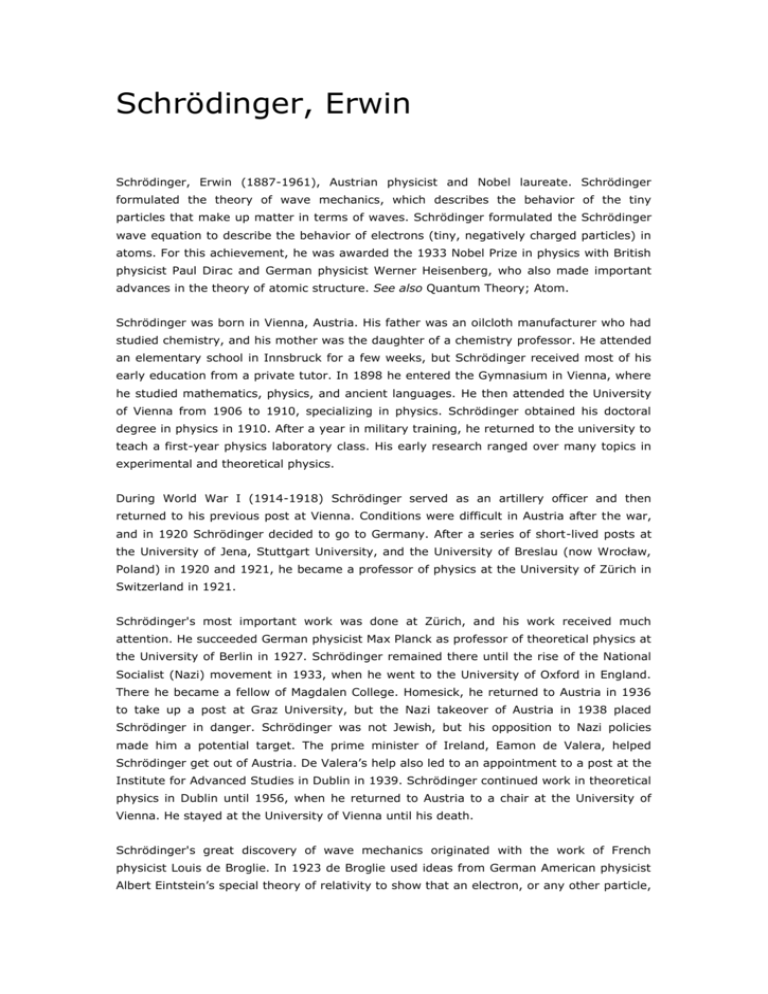
Schrödinger, Erwin
Schrödinger, Erwin (1887-1961), Austrian physicist and Nobel laureate. Schrödinger
formulated the theory of wave mechanics, which describes the behavior of the tiny
particles that make up matter in terms of waves. Schrödinger formulated the Schrödinger
wave equation to describe the behavior of electrons (tiny, negatively charged particles) in
atoms. For this achievement, he was awarded the 1933 Nobel Prize in physics with British
physicist Paul Dirac and German physicist Werner Heisenberg, who also made important
advances in the theory of atomic structure. See also Quantum Theory; Atom.
Schrödinger was born in Vienna, Austria. His father was an oilcloth manufacturer who had
studied chemistry, and his mother was the daughter of a chemistry professor. He attended
an elementary school in Innsbruck for a few weeks, but Schrödinger received most of his
early education from a private tutor. In 1898 he entered the Gymnasium in Vienna, where
he studied mathematics, physics, and ancient languages. He then attended the University
of Vienna from 1906 to 1910, specializing in physics. Schrödinger obtained his doctoral
degree in physics in 1910. After a year in military training, he returned to the university to
teach a first-year physics laboratory class. His early research ranged over many topics in
experimental and theoretical physics.
During World War I (1914-1918) Schrödinger served as an artillery officer and then
returned to his previous post at Vienna. Conditions were difficult in Austria after the war,
and in 1920 Schrödinger decided to go to Germany. After a series of short-lived posts at
the University of Jena, Stuttgart University, and the University of Breslau (now Wrocław,
Poland) in 1920 and 1921, he became a professor of physics at the University of Zürich in
Switzerland in 1921.
Schrödinger's most important work was done at Zürich, and his work received much
attention. He succeeded German physicist Max Planck as professor of theoretical physics at
the University of Berlin in 1927. Schrödinger remained there until the rise of the National
Socialist (Nazi) movement in 1933, when he went to the University of Oxford in England.
There he became a fellow of Magdalen College. Homesick, he returned to Austria in 1936
to take up a post at Graz University, but the Nazi takeover of Austria in 1938 placed
Schrödinger in danger. Schrödinger was not Jewish, but his opposition to Nazi policies
made him a potential target. The prime minister of Ireland, Eamon de Valera, helped
Schrödinger get out of Austria. De Valera’s help also led to an appointment to a post at the
Institute for Advanced Studies in Dublin in 1939. Schrödinger continued work in theoretical
physics in Dublin until 1956, when he returned to Austria to a chair at the University of
Vienna. He stayed at the University of Vienna until his death.
Schrödinger's great discovery of wave mechanics originated with the work of French
physicist Louis de Broglie. In 1923 de Broglie used ideas from German American physicist
Albert Eintstein’s special theory of relativity to show that an electron, or any other particle,
has a wave associated with it (see Albert Einstein). De Broglie’s work resulted in the
equation λ = h/p, where λ is the wavelength of the associated wave, h is a number called
Planck's constant, and p is the momentum of the particle. Physicists immediately deduced
that if particles (particularly electrons) have waves, then a particular type of partial
differential equation known as a wave equation should be able to describe their behavior.
These ideas were taken up by both de Broglie and Schrödinger, and in 1926 each
published the same wave equation. Unfortunately, while the equation is true, it was of
very little help in explaining the behavior of particles.
Later the same year Schrödinger used a new approach. He studied the mathematics of
partial differential equations and the Hamiltonian function, a powerful idea in mechanics
developed by British mathematician Sir William Rowan Hamilton in the mid-1800s.
Schrödinger formulated an equation in terms of the energy of the electron and the energy
of the electric field in which it was situated. Partial differential equations have many
solutions, but solutions to Schrödinger’s equation had to meet strict conditions to be useful
in describing the electron. Among other things, they had to be finite and possess only one
value. These solutions were associated with special values of the electron’s energy level,
known as proper values or eigenvalues.
Schrödinger solved the equation for the hydrogen atom, V = –e2/r, in which V is the
energy of the electric field surrounding the electron, e is the electron's charge, and r is its
distance from the atom’s nucleus. He found that the eigenvalues of the electron’s energy
corresponded with those of the energy levels given in the older theory of Danish physicist
Niels Bohr. Bohr’s theory of the atom described electrons orbiting atoms in strict circular
orbits at particular distances that corresponded to specific levels of energy. In the
hydrogen atom (which consists of one electron and one proton), the wave function
Schrödinger derived instead describes where physicists are most likely to find the electron.
The electron is most likely to be where Bohr predicted it to be, but it does not follow a
strictly circular orbit. The electron is described by the more complicated notion of an
orbital—a region in space where the electron has varying degrees of probability of being
found.
Schrödinger's wave equation can describe atoms other than hydrogen as well as molecules
and ions (atoms or molecules with electric charge), but such cases are very difficult to
solve. In a few such cases physicists have found approximate solutions, usually with a
computer carrying out the numerical work.
Schrödinger's mathematical description of electron waves found immediate acceptance.
The mathematical description matched what scientists had learned about electrons by
observing them and their effects. In 1925, a year before Schrödinger published his results,
German-British physicist Max Born and German physicist Werner Heisenberg developed a
mathematical system called matrix mechanics. Matrix mechanics also succeeded in
describing the structure of the atom, but it was totally theoretical. It gave no picture of the
atom that physicists could verify observationally. Schrödinger's vindication of de Broglie's
idea of electron waves immediately overturned matrix mechanics, though later physicists
showed that wave mechanics is equivalent to matrix mechanics.
During his later years Schrödinger became increasingly worried by the uncertain nature of
quantum mechanics, of which wave mechanics is a part. Schrödinger believed he had
produced a defining description of the atom in the same way that the three laws of English
physicist Isaac Newton defined classical mechanics and the way that the equations of
British physicist James Clerk Maxwell described electrodynamics. Instead, each new
discovery about the structure of the atom only made atomic structure more complicated.
Much of Schrödinger’s later work was concerned with philosophy, particularly as applied to
physics and the atom.
Microsoft ® Encarta ® Reference Library 2003. © 1993-2002 Microsoft Corporation.
All rights reserved.
Schrödinger, Erwin
b. Aug. 12, 1887, Vienna, Austria
d. Jan. 4, 1961, Vienna
Austrian theoretical physicist who contributed to the wave theory of matter and to other
fundamentals of quantum mechanics. He shared the 1933 Nobel Prize for Physics with the
British physicist P.A.M. Dirac.
Schrödinger entered the University of Vienna in 1906 and obtained his doctorate in 1910,
upon which he accepted a research post at the university's Second Physics Institute. He
saw military service in World War I and then went to the University of Zürich in 1921,
where he remained for the next six years. There, in a six-month period in 1926, at the age
of 39, a remarkably late age for original work by theoretical physicists, he produced the
papers that gave the foundations of quantum wave mechanics. In those papers he
described his partial differential equation that is the basic equation of quantum mechanics
and bears the same relation to the mechanics of the atom as Newton's equations of motion
bear to planetary astronomy. Adopting a proposal made by Louis de Broglie in 1924 that
particles of matter have a dual nature and in some situations act like waves, Schrödinger
introduced a theory describing the behaviour of such a system by a wave equation that is
now known as the Schrödinger equation. The solutions to Schrödinger's equation, unlike
the solutions to Newton's equations, are wave functions that can only be related to the
probable occurrence of physical events. The definite and readily visualized sequence of
events of the planetary orbits of Newton is, in quantum mechanics, replaced by the more
abstract notion of probability. (This aspect of the quantum theory made Schrödinger and
several other physicists profoundly unhappy, and he devoted much of his later life to
formulating philosophical objections to the generally accepted interpretation of the theory
that he had done so much to create.)
In 1927 Schrödinger accepted an invitation to succeed Max Planck, the inventor of the
quantum hypothesis, at the University of Berlin, and he joined an extremely distinguished
faculty that included Albert Einstein. He remained at the university until 1933, at which
time he reached the decision that he could no longer live in a country in which the
persecution of Jews had become a national policy. He then began a seven-year odyssey
that took him to Austria, Great Britain, Belgium, the Pontifical Academy of Science in
Rome, and--finally in 1940--the Dublin Institute for Advanced Studies, founded under the
influence of Premier Eamon de Valera, who had been a mathematician before turning to
politics. Schrödinger remained in Ireland for the next 15 years, doing research both in
physics and in the philosophy and history of science. During this period he wrote What Is
Life? (1944), an attempt to show how quantum physics can be used to explain the stability
of genetic structure. Although much of what Schrödinger had to say in this book has
been modified and amplified by later developments in molecular biology, his book remains
one of the most useful and profound introductions to the subject. In 1956 Schrödinger
retired and returned to Vienna as professor emeritus at the university.
Of all of the physicists of his generation, Schrödinger stands out because of his
extraordinary intellectual versatility. He was at home in the philosophy and literature of all
of the Western languages, and his popular scientific writing in English, which he had
learned as a child, is among the best of its kind. His study of ancient Greek science and
philosophy, summarized in his Nature and the Greeks (1954), gave him both an
admiration for the Greek invention of the scientific view of the world and a skepticism
toward the relevance of science as a unique tool with which to unravel the ultimate
mysteries of human existence. Schrödinger's own metaphysical outlook, as expressed in
his last book, Meine Weltansicht (1961; My View of the World), closely paralleled the
mysticism of the Vedanta.
Because of his exceptional gifts, Schrödinger was able in the course of his life to make
significant contributions to nearly all branches of science and philosophy, an almost unique
accomplishment at a time when the trend was toward increasing technical specialization in
these disciplines.
Schrödinger equation
the fundamental equation of the science of submicroscopic phenomena known as quantum
mechanics. The equation, developed (1926) by the Austrian physicist Erwin Schrödinger,
has the same central importance to quantum mechanics as Newton's laws of motion have
for the large-scale phenomena of classical mechanics.
Essentially a wave equation, the Schrödinger equation describes the form of the probability
waves (or wave functions [see de Broglie wave]) that govern the motion of small particles,
and it specifies how these waves are altered by external influences. Schrödinger
established the correctness of the equation by applying it to the hydrogen atom, predicting
many of its properties with remarkable accuracy. The equation is used extensively in
atomic, nuclear, and solid-state physics.
Schrödinger's wave mechanics
from quantum mechanics
Schrödinger's wave mechanics
Schrödinger expressed Broglie's hypothesis concerning the wave behaviour of matter in a
mathematical form that is adaptable to a variety of physical problems without additional
arbitrary assumptions. He was guided by a mathematical formulation of optics, in which
the straight-line propagation of light rays can be derived from wave motion when the
wavelength is small compared to the dimensions of the apparatus employed. In the same
way, Schrödinger set out to find a wave equation for matter that would give particle-like
propagation when the wavelength becomes comparatively small. According to classical
mechanics, if a particle of mass me is subjected to a force such that its potential energy is
V(x,y,z) at position x,y,z, then the sum of V(x,y,z) and the kinetic energy p2/2me is equal
to a constant, the total energy E of the particle. Thus,
It is assumed that the particle is bound--i.e., confined by the potential to a certain region
in space because its energy E is insufficient for it to escape. Since the potential varies with
position, two other quantities do also: the momentum and, hence, by extension from the
Broglie relation, the wavelength of the wave. Postulating a wave function (x,y,z) that
varies with position, Schrödinger replaced p in the above energy equation with a
differential operator that embodied the Broglie relation. He then showed that satisfies the
partial differential equation
This is the (time-independent) Schrödinger wave equation of 1926, which established
quantum mechanics in a widely applicable form. An important advantage of Schrödinger's
theory is that no further arbitrary quantum conditions need be postulated. The required
quantum results follow from certain reasonable restrictions placed on the wave function-for example, that it should not become infinitely large at large distances from the centre of
the potential.
Schrödinger applied his equation to the hydrogen atom, for which the potential function,
given by classical electrostatics, is proportional to -e2/r, where -e is the charge on the
electron. The nucleus (a proton of charge e) is situated at the origin, and r is the distance
from the origin to the position of the electron. Schrödinger solved the equation for this
particular potential with straightforward, though not elementary, mathematics. Only
certain discrete values of E lead to acceptable functions
. These functions are
characterized by a trio of integers n, l, m, termed quantum numbers. The values of E
depend only on the integers n (1, 2, 3, etc.) and are identical with those given by the Bohr
theory. The quantum numbers l and m are related to the angular momentum of the
electron; l(l + 1) is the magnitude of the angular momentum, and m is its component
along some physical direction.
The square of the wave function, 2, has a physical interpretation. Schrödinger originally
supposed that the electron was spread out in space and that its density at point x,y,z was
given by the value of 2 at that point. Almost immediately Born proposed what is now the
accepted interpretation--namely, that 2 gives the probability of finding the electron at
2 is small at a
x,y,z. The distinction between the two interpretations is important. If
particular position, the original interpretation implies that a small fraction of an electron
will always be detected there. In Born's interpretation, nothing will be detected there most
of the time, but, when something is observed, it will be a whole electron. Thus, the
concept of the electron as a point particle moving in a well-defined path around the
nucleus is replaced in wave mechanics by clouds that describe the probable locations of
electrons in different states.

